By Bus & Rail
Metro beer and wine ad proposal falls flat
March 18, 2010
The beer that made Milwaukee famous won’t be riding L.A. public transportation any time soon.
After a discussion liberally spiked with references to Schlitz—and even, briefly, to Blatz—a Metropolitan Transportation Authority committee voted unanimously today to reject a proposal that would have allowed beer and wine ads on the agency’s buses and trains.
Metro’s communications staff told the committee that accepting beer and wine ads could yield $500,000 a year for the agency in a 50-50 split with its advertising vendor, CBS Outdoor.
A number of big city transit agencies, including New York’s MTA, permit such advertising, but Metro would have been the first to do so in California—a distinction none of the committee members seemed eager to claim.
“For the amount of money you’re talking about, for us to be the first in California to advertise alcoholic beverages on our buses rubs me the wrong way,” said Supervisor Zev Yaroslavsky, a Metro director and member of its Executive Management and Audit Committee.
Yaroslavsky also questioned whether the revenue split was in the agency’s best interests.
Another member of the committee, Richard Katz, said he shared those concerns and suggested there were better ways to bridge a $181 million deficit in the coming fiscal year.
“I’d much rather explore naming rights at station locations and things like that to generate revenue before I’d put alcohol on buses,” Katz said.
“Schlitz station?” Yaroslavsky quipped.
“That would be the old abandoned station, yeah, that would be the Schlitz station,” Katz parried back.
Committee chair Ara Najarian said he had “personal objections to alcohol advertising.”
“I think much of it nationally is targeted to minority groups,” he said. “I think it encourages a behavior that is not productive, during certain hours of the day at least. And I don’t think we can regulate the content.”
“If we said we would permit Schlitz to endorse a message such as ‘Drink responsibly, let Metro be your designated driver,’ we can’t restrict to that,” Najarian said.
Metro adopted its policy banning alcohol and tobacco ads in 1997, at the behest of then-Supervisor Yvonne Brathwaite Burke, who said it was a matter of good public health policy. Subway riders interviewed this week seemed split on whether it was appropriate to make an exception for beer and wine ads. (See our earlier story here.)
But among the Metro committee members, the feeling was unanimous: current policy should stand.
It seemed for a moment that the committee’s vice-chair, Supervisor Don Knabe, would have the last word on the matter:
“A half a million bucks is not worth the heartache, trust me,” Knabe said.
Then Yaroslavsky offered this: “Can we get some money from Schlitz, just for having brought their name up?”
Posted 3/18/10
This ad’s for you, if Metro shifts gears
March 17, 2010
It’s been 13 years since they dimmed the lights and sounded last call for beer and wine advertising on local buses and trains.
Now those ads could be on tap again.
A proposal to bring back such advertising goes before a Metropolitan Transportation Authority committee this week. The idea has surfaced as Metro faces a $181 million deficit—and likely staff cuts and service reductions–in the coming fiscal year that begins in July.
CBS Outdoor, Metro’s advertising vendor, said it would split the revenue generated by the new beer and wine advertising with the agency, generating about $500,000 a year for Metro, according to the report to be considered by the Executive Management and Audit Committee on Thursday. That amount would be on top of Metro’s revenue from other CBS Outdoor advertising, which is set at a flat fee of $27.9 million in the coming fiscal year.
Ads for tobacco and other alcoholic beverages would remain off-limits.
Warren Morse, Metro’s deputy executive officer for communications, said the idea of reinstating beer and wine advertising originated with CBS Outdoor and was being presented to the committee as one possible revenue-generating option.
“We didn’t bring this up to be controversial,” he said. Morse said that the cities of Los Angeles, West Hollywood and Inglewood allow beer and wine advertising on bus shelters in their areas, which account for 85% of the shelters in the county.
Metro banned tobacco and alcohol advertising on its vehicles in April, 1997, on a motion by then-Supervisor Yvonne Brathwaite Burke, who was also on the Metro board of directors at the time. (The current policy is here. )
Burke, who retired in 2008, said in an interview that she had introduced the motion as a matter of good health policy. She said public transportation passengers are a captive audience, and alcoholics, in particular, could be placed in a difficult situation if they are unable to avoid seeing such ads.
“You have an audience that is almost kidnapped,” Burke said. “I just wonder how much money is going to be generated to make it worth it.”
Metro riders interviewed this week seemed divided on whether beer and wine ads should be allowed to share their afternoon commute.
“I don’t want to see it,” said Red Line subway passenger Joe Barry. “There is already enough exposure. I don’t see why it has to be featured down here as well.”
“I don’t need to have it in my face every minute of the day,” added Paul Donaldson, another Red Line rider. “I can get that enough from TV.”
But Avis Jackson, riding the Purple Line, said, “It doesn’t matter because the advertising is everywhere else and is so overexposed.”
Added Michael Paz, waiting to board the Purple Line: “It’s fine with me if it creates some money for the city.”
CBS Outdoor senior vice president Rich Ament said the change makes financial sense. He said beer and wine advertising represents a “serious opportunity” for Metro to receive revenue from what is “essentially a recession-proof product.”
“Beer and wine advertising is everywhere,” Ament said. “The only place it doesn’t exist is on the (L.A.) transit system… It exists pretty much everywhere else.”
New York’s Metropolitan Transportation Authority is among the big city transit systems that allow such advertising. But San Francisco’s does not.
“Tobacco and alcohol advertising are seen as not appropriate on public transportation vehicles that are publicly funded,” said Murray Bond, deputy director for communications at San Francisco’s Municipal Transportation Agency.
Posted 3/17/10
Bus riders to be affected by 405 project, too
March 11, 2010
Some Westside bus passengers will soon be taking the scenic route.
And Metro would like to apologize for that in advance.
Starting in mid-March, patrons of various Metro bus lines in the Sepulveda Pass and West Los Angeles could be facing delays and detours due to the 405 Sepulveda Pass Widening Project, which will add a 10-mile northbound carpool lane to the freeway.
Bus lines that travel on the freeway and through the construction area will be affected off and on until the project’s completion, now scheduled for 2013.
Lines slated to be affected are as follows:
• Line 2-302: Sunset Boulevard
• Lines 4 and 704: Santa Monica Boulevard
• Lines 20, 720 and 920: Wilshire Boulevard
• Line 761: Sepulveda Boulevard and 405
Regular updates are available on Twitter.
Posted 3/11/10
MTA board looks at Regional Connector alternative
February 18, 2010
An alternative design for the Regional Connector Transit Corridor project will come before the Metropolitan Transportation Authority Board at its meeting next week.
The Regional Connector, which is receiving Measure R funding, will help Gold Line, Blue Line and eventually Expo Line commuters make seamless connections across the region.
The design alternative, which would go underground in Little Tokyo, is being recommended by Metro staff to be included for study as part of the project’s environmental review process.
The MTA board meets at 9:30 a.m. on Thursday, Feb. 25.
Posted 2-18-10
Growing the Orange Line
February 16, 2010
The Orange Line is going places.
Brutoco Engineering & Construction, Inc. has been selected to design and build a four-mile northerly extension of the Orange Line from Warner Center to Chatsworth.
The busway currently runs from Warner Center to North Hollywood, where riders can catch the Red Line subway to Downtown L.A. or points beyond.
The Orange Line has been a hit with riders—currently carrying more than 20,000 each weekday, triple the number originally envisioned when it opened in 2005—and the extension seeks to build on that popularity while expanding transportation “connectivity” within the area.
The Orange Line extension project includes four new stations, to be located at Sherman Way, Roscoe Boulevard, Nordhoff Street and the Chatsworth Metrolink Station.
Other elements of the extension include new platforms at Canoga Station and an elevated bridge over railroad tracks at Lassen Street. In addition, the project includes a bicycle/pedestrian path connecting to an existing path at Brown’s Creek, a park-and-ride lot at the Sherman Way Station, expanded parking at the Chatsworth Metrolink Station, bridge crossings over the Los Angeles River and Santa Susana Wash, a satellite bus parking facility, and landscaping and street improvements.
The extension is expected to open in the summer of 2012.
The $82.5 million design build contract awarded to Brutoco is the first to be funded by Measure R, the half-cent sales tax passed by voters in 2008. The overall budget for the extension project is $215.6 million.
Read our earlier story on the Orange Line here.
Posted 2/16/10
Return of the Mini-Vib
February 10, 2010
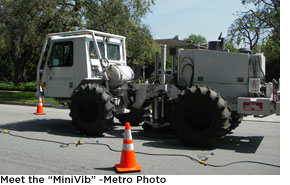 The Mini-Vib’s back, and this time it’s bringing along its seismic sidekick, the Micro-Vib.
The Mini-Vib’s back, and this time it’s bringing along its seismic sidekick, the Micro-Vib.
Westside subway extension planners are sending the Mini-Vib truck back into service next week on a new stretch of Selby Avenue north of Santa Monica Boulevard in Westwood. The vibration-creating vehicle will roll over sensors in the street between 8:30 a.m. and 5 p.m. on Monday, Feb. 15. (The work was scheduled on the President’s Day holiday to avoid disrupting classes at Emerson Middle School.) This round of testing comes after preliminary data suggested going a little further north on Selby with the Mini-Vib.
That work will be followed up with an appearance by the Micro-Vib on Wednesday and Thursday nights on Selby Avenue from Santa Monica Boulevard north. The hand-held “vibration box” is designed to produce gentler vibrations than the truck. With noise levels of around 60 decibels—about as loud as normal conversation–it will be used between 9 p.m. to 6 a.m. both nights. More Micro-Vib tests may be scheduled for Saturday, Feb. 27 as well.
The Mini-Vib truck also will be paying a return visit to Century Park West next week. Testing will take place on Tuesday, Feb. 16 from 9 p.m. to 6 a.m. between 1930 Century Park West and Santa Monica Boulevard. The work is needed because of a malfunction during the earlier round of testing.
This letter to residents, posted by Metro’s blog The Source, has more on the testing process, and describes the impact on traffic, including lane closures on Santa Monica Boulevard the night of Tuesday, Feb. 16.
Ultimately, results of the field seismic tests will be used to help determine routes for tunnels connecting the Century City and Westwood/UCLA subway stations. The research centers on a branch of the Santa Monica fault in the area. Full information on the project, which is still in the planning stages, can be found here.
A milestone for Expo—and the Westside
February 4, 2010
The Expo Line is ready to roll west.
Directors of the Exposition Metro Line Construction Authority on Thursday evening approved the final environmental impact report for Phase 2 of the light rail project after years of study and months of community input and debate.
The vote clears the way for selection of a contractor to design and build the $1.5 billion project, which would complete the Culver City- to-Santa Monica segment of the 15.2-mile line.
Construction on Phase 1, which parallels the heavily-congested Santa Monica Freeway and runs from downtown to Culver City, is now underway and aiming for completion in 2011. Some work on Phase 2 could begin as early as this year, with the project scheduled to wrap up in 2015. By 2030, the entire line is projected to carry 64,000 riders a day.
Proponents of the line say it will be a boon for anyone who drives to, or from, the Westside, especially those who must battle traffic on the 10 Freeway. For tourists, students and the region as a whole, the completed light rail line will provide access to an array of cultural and community venues in downtown and beyond, including Exposition Park/USC, the Crenshaw District and the beach.
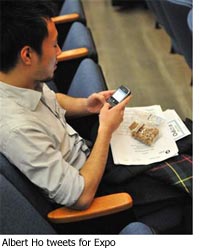 The vote attracted considerable attention, with hundreds of people on all sides of the issue attending the meeting in the Hall of Administration. In addition, Expo was a hot topic for social networking, with one blogger—Damien Newton of Streetsblog Los Angeles—delivering play-by-play reports on the meeting via Twitter. Albert Ho, an Expo community outreach consultant, also tweeted throughout the proceedings.
The vote attracted considerable attention, with hundreds of people on all sides of the issue attending the meeting in the Hall of Administration. In addition, Expo was a hot topic for social networking, with one blogger—Damien Newton of Streetsblog Los Angeles—delivering play-by-play reports on the meeting via Twitter. Albert Ho, an Expo community outreach consultant, also tweeted throughout the proceedings.
Opponents, many of them with a group called Neighbors for Smart Rail, said they were not against a rail system per se but wanted it to run underground for reasons of safety and quality of life. That option has been ruled out, in part because of the cost.
Those speaking in favor of the plan—an array of homeowners, business people, educators, college students and political leaders from across the region—offered testimony that focused on the need to solve the area’s traffic overload, bring workers to Westside jobs and deliver on the will of the voters who approved Measure R, which will largely finance the rail line.
After nearly four hours of public testimony, the Expo board members had their say.
“This part of town, this part of the county, has waited a long time for this. The time for action has come,” said Zev Yaroslavsky, Expo board member and 3rd District County Supervisor. (Read his blog on the Expo Line project here.)
The Expo Line—together with another project now in the planning stages, the Westside Subway extension—will represent a transit breakthrough for a jobs-rich area that has had to rely on buses for its mass transportation needs as a region-wide rail system has grown up around it in recent decades.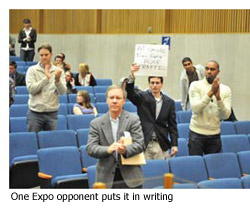
When all is completed, the Expo Line will make it possible to travel from downtown Los Angeles to Culver City in less than 30 minutes, and to ride the entire length of the line in 46 minutes.
“It’s a big step forward for the region,” said Expo board member and Culver City Councilmember Scott Malsin.
“With 200,000 cars coming [into Santa Monica] every day, every one of my streets is gridlocked. I’ve had it up to here with gridlock,” added board member Bill Rosendahl, acting as alternate for his L.A. City Council colleague Jan Perry.
Yaroslavsky, Malsin and Rosendahl joined L.A. City Councilmembers Herb Wesson, Jr. and Bernard C. Parks and Santa Monica City Councilmember Gleam Davis in approving the final environmental impact report. Dan Rosenfeld, acting as alternate for County Supervisor Mark Ridley-Thomas, abstained.
Ridley-Thomas, before leaving the meeting early, had offered a motion that would have delayed a decision on the report until the Metro CEO could finish a review of the agency’s grade crossing policy. That motion was defeated.
The route approved by Expo directors includes seven stations: National/Palms, Expo/Westwood, Expo/Sepulveda, Expo/Bundy, Olympic/26th Street, Colorado/17th Street and Colorado/4th Street.
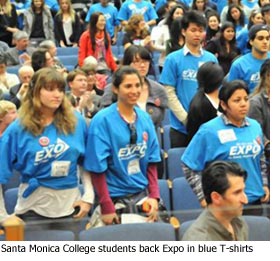 In preparing the final environmental review, the Expo staff received thousands of public comments on the project. Most were supportive but some raised key questions about traffic, grade crossings, parking, noise and vibration, the proximity to schools and the location of the project’s maintenance facility.
In preparing the final environmental review, the Expo staff received thousands of public comments on the project. Most were supportive but some raised key questions about traffic, grade crossings, parking, noise and vibration, the proximity to schools and the location of the project’s maintenance facility.
In addressing those concerns, Expo staff made a number of modifications in the environmental plan presented to the board of directors.
The “locally preferred alternative” plan recommended new elevated grade separations at a number of intersections: Venice Boulevard, Bundy, Centinela, Pico-Gateway, Cloverfield/Olympic and Sawtelle.
More changes came from the Expo board Thursday. On a motion by Yaroslavsky, the directors included an option to build an aerial station at Expo/Sepulveda if funding could be found. The plan also calls for a 170-space parking lot at the Westwood Boulevard station. But the board approved a motion by Yaroslavsky to keep open the possibility of building the station without a parking lot. That could allow for the creation of a landscaped greenway at that location.
In addition, the plan presented to Expo directors recommended a “buffer design option” for the maintenance facility to be built in Santa Monica. The facility would be constructed on what is now a Verizon maintenance yard and a Santa Monica City College parking lot at Exposition Boulevard and Stewart Street. It would include a 100- to 110-foot buffer between the facility and a residential area on the south side of Exposition.
Other changes include allowing parking on the east side of Westwood Boulevard between 7 a.m. and 7 p.m. and doing more to mitigate noise and vibration around such locations as sound and recording studios and schools.
Expo officials describe the line as a “Transit Parkway” that will include pedestrian paths, trees and landscaping, and a bikeway along the alignment, all the way from downtown L.A to Santa Monica. The cities of Santa Monica and Los Angeles have finalized the bikeway design and are awaiting federal environmental approval of the plan.
The plan calls for awarding a preliminary engineering contract by March and a design and construction contract in the fall.
Westside Subway 101
January 29, 2010
 It takes a while to plan a subway. So for those who want a cheat sheet to catch up with everything that’s happened so far in the plan to create a westward extension of the Purple Line, check out this list of frequently-asked questions just posted on the Metro site.
It takes a while to plan a subway. So for those who want a cheat sheet to catch up with everything that’s happened so far in the plan to create a westward extension of the Purple Line, check out this list of frequently-asked questions just posted on the Metro site.
If you want a more up-close-and-personal tutorial, consider attending a brown bag lunchtime open house in Century City on Tuesday, Feb. 2, from 11:30 a.m. to 2 p.m. You will need to bring your own potato chips, but the transit talk and video presentation are free.
Little truck, big job, for Westside subway planning
January 7, 2010
 That rumbling outside isn’t the Big One—just a little visit from the minivib.
That rumbling outside isn’t the Big One—just a little visit from the minivib.
The “minivib”—a small truck that plays a starring role in seismic testing for the Westside Subway extension—will be paying a visit to Century City and Westwood neighborhoods next week. Its “field seismic investigations” will take place on Century Park West and Warnall Avenue on Jan. 12 and 13, beginning at the parking entrance for 1930 Century Park West and ending on Warnall at Eastborne Avenue. On Jan. 14 and 15, the work starts on Selby Avenue, beginning at a point between LaGrange and Missouri Avenues and ending at North Temple Way.
The seismic testing will produce an electronic image of the soil, including rock layers, near-surface faulting and information on bedrock elevations and depths. The process involves placing sensors along the street and then having the minivib press and vibrate a “plate” every two feet to obtain readings of the vibrations.
Ultimately, the work will help determine placement of subway tunnels and stations in Century City and Westwood. Anyone with questions about the testing can leave a message at (213) 922-6934 or email Metro via the “Contact Us” link here. For urgent matters, call (323) 889-5311.
About 240 letters have gone out to residents alerting them of the work, which will take place between 10 p.m. and 6 a.m. The night shift is necessary, according to Metro, to avoid competing vibrations from daytime traffic and to minimize disruption on nearby Santa Monica Boulevard, which will be reduced to one lane in each direction during the testing.
Metro says the noise will be moderate–not more than 70 decibels, in the range of daytime traffic volume–and should take no longer than 30 minutes in front of any one residence.
It’s a busy week for after-hours transportation action on the Westside–on Tuesday night, work also will begin on the 405 Sepulveda Pass widening project, as crews begin delineating new, narrower lanes to accommodate a work zone for the construction of a northbound carpool lane. More information on that project can be found here.




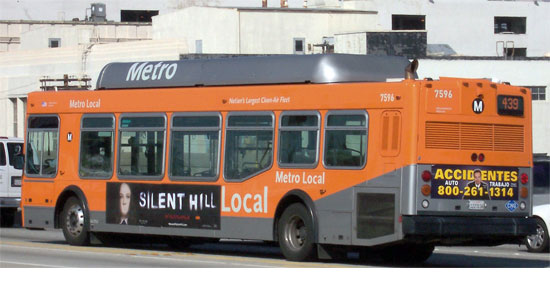

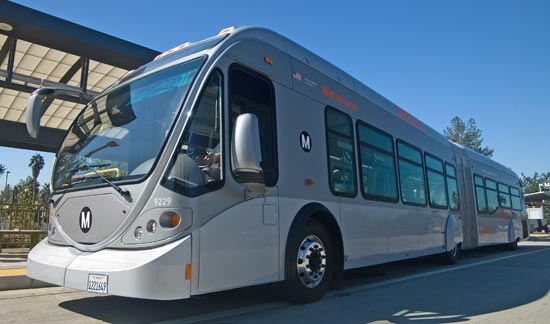
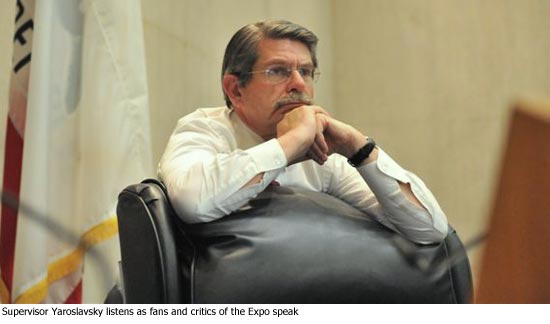
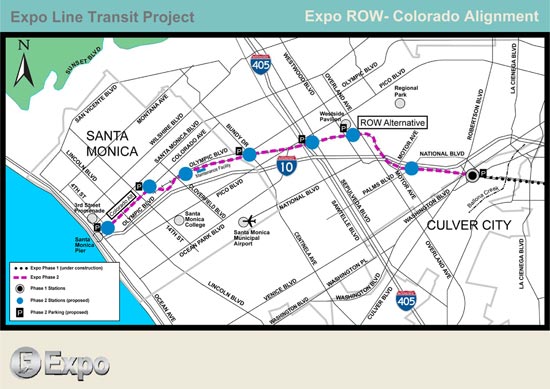







 405 bridge work causes a stink
405 bridge work causes a stink

